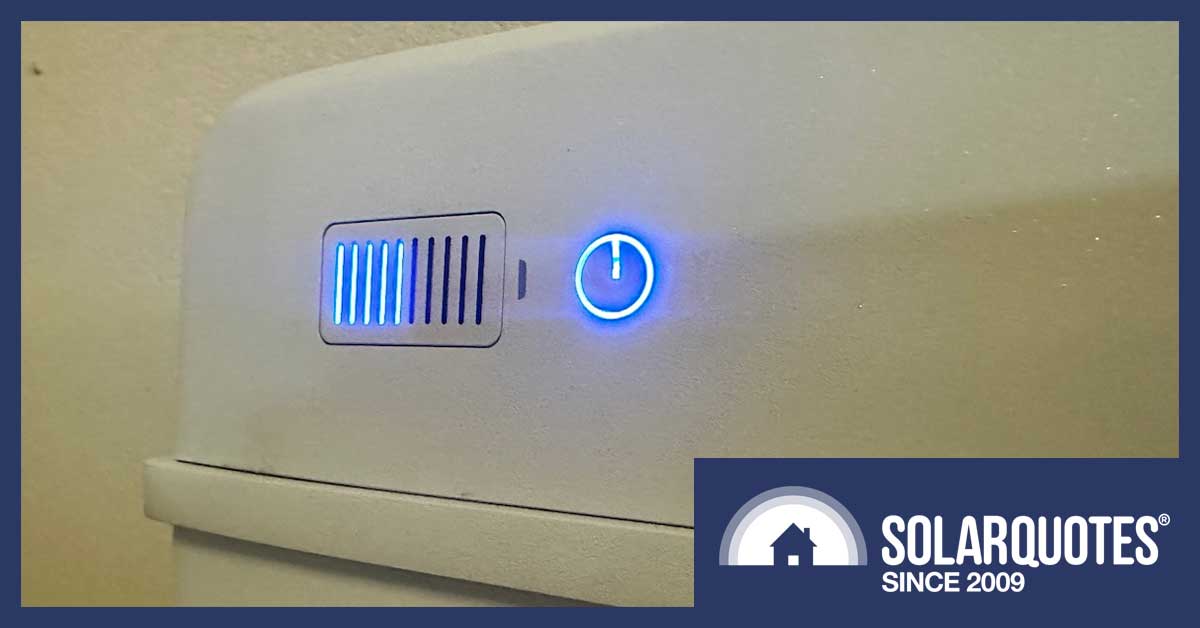
In this first of a two-part series, we’re going to shed light on some of the lurks you need to know about owning a battery hybrid solar power system. Specifically understanding, measuring and managing the degradation.
Which Battery Specifications Degrade?
- Firstly there’s the rated capacity in kilowatt hours (kWh). This refers to the volume of energy your battery can hold. Unlike a water tank, your battery’s capacity will effectively shrink over time. Warranties typically account for this saying they’ll deliver perhaps 60% of the rated capacity after a decade in service*
(the asterisk refers to special conditions in the fine print, which is where the grief begins)
- Secondly, there’s the surge capacity or C rating, which is essentially how much energy the battery can deliver all at once. This factor is often overshadowed by the inverter’s peak capacity in kilowatts (kW). Imagine this as the size of the hose coming from the tank. When you open the tap, water can gush out, but it also needs some head pressure to drive it at more than a dribble. You’ll encounter this with some hybrids that use modular batteries because they need 3 cell blocks for basic functionality, but full headline output needs 5 cell blocks in the battery, which can go on to be 9 in a stack. It’s a bit like comparing a tank to a water tower.
Understanding Battery Degradation: How Will You Know?
As the battery ages, you’ll probably not notice your grid-connected battery doesn’t quite deliver the punch it once did. There are a few reasons, but they stem from the fact that lithium batteries are managed by a layer of electronics (a BMS) to ensure they’re kept in the Goldilocks zone of temperature and charge.
For instance, you can hear when the starting battery in your car is under peak load cranking the engine. When it’s old, sick or just flat, then it’s obvious you need a jump start.
Whereas your house battery system, when trying to crank up the fridge, has a permanent jumper cable connected to the main grid. If the battery doesn’t deliver the required grunt, the grid steps in, and this is why cheap rubbish hybrid systems get away with poor surge ratings; they rely heavily on big brother to help out.
If you keep an eye on the monitoring, you will notice the amount of energy the battery will store overall. Say it’s 10kWh; when new, you may see it reaches 100% state of charge at 12pm. Then at sundown, you get 5 hours of use at a steady 2kW discharge running the air conditioning. Ten years later, it takes less time to fill, and you’ll find it only lasts for 3 hours in the evening.
It’s worth sizing your battery with this in mind.
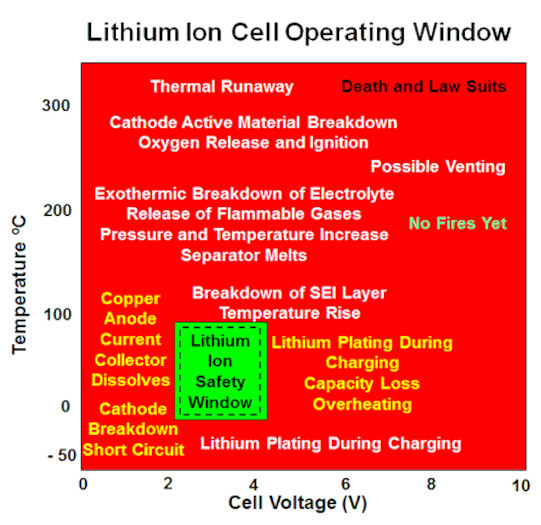
The battery management system (BMS) monitors temperature, manages voltage and limits current, keeping your lithium cells in a comfortable window. Image credit www.mpoweruk.com
What Shortens Battery Life?
Temperature. It’s that simple.
Anything electrical creates heat in operation, batteries in particular, because of the chemical action inside them. In Australia, keeping your battery cool is a no-brainer. The best battery enclosure I ever saw was a concrete bunker under a garage, a wine cellar for electricity storage, if you will.
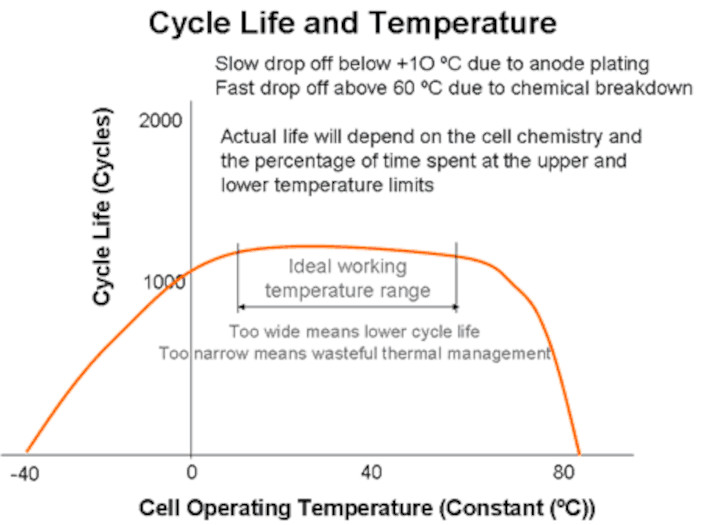
You need not add any ambient temperature from a hot summer’s day in Australia, but a Canberra winter might not help either. Image credit www.mpoweruk.com
Bear in mind batteries have both a cycle life and a shelf life. Leaving them on a shelf is one of the worst things you can do. Lithium chemistries are pretty durable (while Nickel Iron NiFe will outlast Keith Richards,) but for a lead acid battery, discharging it and leaving the battery stand will ruin it in a few weeks flat. Pun intended.
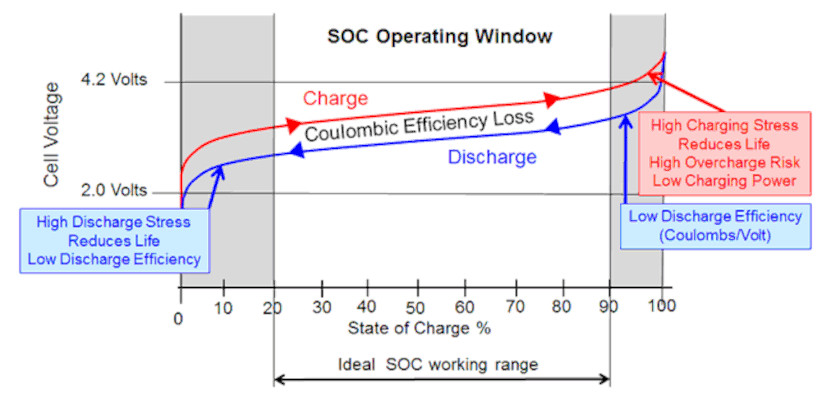
20% – 90% is where lithium cells work best, but what you’ll find is engineers design their BMS to avoid the extremes shown here. The user interface might display “FULL” at 80% and “FLAT” 30% and as the battery ages, the management might also extend the range used to mask degradation. image credit www.mpoweruk.com
The Impact of Battery Size on Long-Term Performance
The importance of correct battery sizing cannot be overstated.
You, the customer, need to know how much you want. Something modest to keep the lights and fridge going overnight? Or something ludicrous if you’re going to run the air conditioning and trade on the electricity spot market.
Deep depths of discharge should be avoided if possible, if only because some warranties are rendered void if you work the batteries too hard.
When you buy a modern, high-voltage hybrid package, the factory makes complex engineering decisions about chemistry, size & BMS to give you performance that meets its kilowatt-hour sticker rating. In contrast, a traditional off-grid system will be specified by the system designer that does the installation, so you might get to see “under the bonnet” in terms of cells, voltages, C rates and amp-hour ratings.
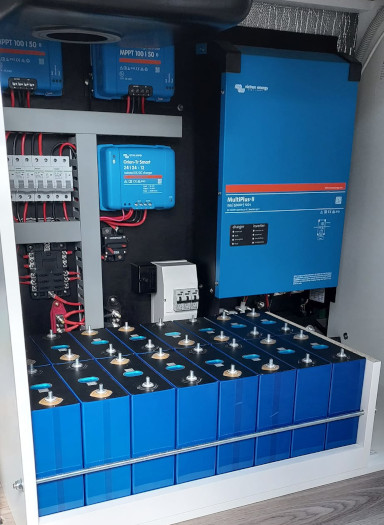
Not under the bonnet but under the sink. This unfinished caravan power system shows an open bank of individual 3.7volt prismatic cells. It’s nicely done but unlikely to be compliant.
How conservative are the battery specifications?
When Harley Davidson released their first ever electric motorcyle;
- They specified a 15kWh battery and gave it range and warranty ratings to suit.
- Owners have been really pleased with it’s durability, they’re not losing range or performance.
- A fairly sensible rumour has it that this machine runs a 20kWh pack and it’s just being very conservatively managed by the BMS as a 75% smaller unit.
It makes perfect sense that an expensive legacy brand, entering its first product into a new market, wants to ensure it doesn’t become a disaster, so they’ve built in a 25% safety margin. As a domestic battery customer, you need to weigh up how conservative you think the engineers are when specifying your battery.
It’s an impossible task, but really, the only way to judge is;
- What warranty are they offering
- For how much performance
- At a given price.
- And, of course, will they be around to honour the warranty?
Suppose you are offered a cheap home battery with a crappy warranty compared to others on the market. In that case, you are likely getting less battery than other products with the same official specification. Battery warranties matter. Read them.
So How Can We Weigh Up, Gauge Depth and Measure It?
In our next instalment, I explain with a worked example how you can measure your battery’s degradation and – if you submit a warranty claim – how the vendor will measure it to decide if they will honour that claim.

 RSS - Posts
RSS - Posts



When you say “Deep depths of discharge should be avoided” does this mean flatlining the battery is contraindicated?
For a household that averages 5 kWh in use overnight, does that mean a 5 kWh battery would actually not suit as while you may only cycle the battery once per 24 hour period, you’d empty it each time? What size battery should such a household procure?
Obviously if you use more, or less, power on average you’d need to multiply, or divide to reach the relevant figure, but I’m curious how recommended purchase size relates to actual use, especially given the price per kWh is far far higher for smaller battery systems.
Yes, but, for us off-gridders, surprise, surprise we re still using Valve regulated Pb-acid (gel) batteries. Sure 70% of the capacity really
doesn’t do much but they are here, installed, working fine and why
should we change?
We have developed a desulphating technology that actually seems
to work (>1000A pulses) for our 24V system – but our “n” is a trifle inadequate. Any one else interested? (It can easily be boosted to
about 3+ thousand amps). (and yes, those currents are real!)
You guys continue to address nearly all your comments to those conventional mainstreamers who are connected to the grid. Of course, that includes most of your readers, I know, but it does leave us out-of-the-boxers feeling quite neglected when you don’t even remember that we exist. We do!
Hey, I know! How about – when you say something that’s true only for the conventional mainstream suburbanites – that you remember to qualify it to include us off gridders too?! How great would that be? And it wouldn’t cost you a thing!
Win-win! Diversity, Inclusivity, help the environment, and all that jazz!
Here you go: https://www.solarquotes.com.au/blog/lead-vs-lithium-batteries/
Brilliantly clear presentation of “Batteries 101 for Owners”. It’s essential knowledge, I figure, but rarely seen in one refined dollop like yours. Hiding the more technical details in the graphs makes it more palatable to a varied audience.
I’m eyeing a bank or two of those prismatic LiFePO₄ cells with a suitable BMS, and planning to run them between 3.1v and 3.45v for longevity. Even though that ought to be around 10% to 95% SoC, the top is at the bottom of the steep LiFePO₄ top charging knee, well down from the specification limit of 3.65v, which is the usual BMS disconnect point. And 3.1v ought to be far enough up the low end knee to avoid accelerated deterioration. We’ll see.
I’ll have to look into compliant battery shelving and the required degree of enclosure. Certainly, an insulating shield over the battery terminals and the interconnecting busbars is essential, as a dropped torque wrench would cause flash burns. (Would do my beard no good at all!)
Rather than risk temperature extremes outside, I’m hoping to have the batteries and inverters installed in an insulated workshop. That may end up airconditioned, but only while there’s sufficient PV. A west-facing 3 kW array, tilted 40 deg., will help there – necessary as it’s off-grid. As the Victrons can be a bit noisy on heavy load, I understand, the far end of the 8m long workshop from the attached dwelling, sounds preferable.
P.S. Following the end of the Raspberry Pi drought, I’ve just installed VenuOS 3.0 on a RPi4, and connected it to my network. If I’m to customise aspects of even the low level configuration of VenusOS, then it’s essential to have an off-line system to make mistakes on. Anyway, the real thing isn’t here yet. (The RPi runs the same VenusOS variant as the Victron CCGX system controller, I understand.)
Interesting read on nominal battery capacity, and the amount available while maintaining battery life. My reading of the articles above is that minimum charge 20%, max charge 80% for long battery life.
Therefore plan for a battery capacity about 50% more than nominal, to get long life.
If this philosophy also applies to electric vehicles, then travel distances will be much less and recharging points will be critical. But, will fast recharging reduce battery life? 30-40 minutes is a much publicised recharge period, to fit in with a typical weekly supermarket shopping expedition. But to provide this, the supermarket will require a few 50kW charging outlets. Not cheap (50kW is equivalent to 8 large electric stoves, simultaneously).
Not a cheap investment by the supermarket.
In country areas, the supermarket (or petrol station) will need a new transformer and main supply cables to the servo/supermarket. Cost likely $100k or more, so the servo/supermarket will want to sell electricity at 2-3 times the cost – perhaps 60-90 cents per kWh.
At home, just an additional charging point of only 35amps (equal to one stove) will stretch the supply to a house. If each house has an electric car in future rather than petrol, then the suburban substation and distribution mains will need a substantial upgrade. Solar panels on your roof will not cope, especially if you want to recharge your batteries after returning home from work.
Thanks for the articles above. We have interesting times ahead as Australia tries to reduce its CO2 emissions.
I have a Powerwall 2. Max available is 9.7KW after 36 months. This is 72% of new, assuming 13.5KW was avaialble new. No so good – otherwise I’ve been very happy with everything else about the Powerwall 2. (Can provide screenshots if you like). Might be testing Tesla warranty response soon – I understand they guarantee to 70% after 10 years.
Hi Ray
There are a few of us with this issue, ours is the July 2019 batch of Powerwall 2’s. Tesla contacted me in August 2022 and warned me to monitor the Nominal Capacity. Has your PW2 reached the replacement stage ?.
My concern is what appears to be active battery management by the Tesla system of my degrading PW2. It degraded 12%pa for the 1st 2 years and since the Tesla contact, has only degraded 1.6%pa in the last 2 years. We have now lost 27% over 4 years. Some UK users have mentioned that Tesla have told them that they are managing their poor performing Powerwall 2’s.
I have also noticed that newer installations of Powerwall 2’s have an increased “over 13,500Wh”, like about 12%, up to around 15,100Wh total. which appears to drag out help drag out the warranty. Used to be 5%.
When you lookup the Energy Authorities and “Fit for Purpose”, it is waited towards EV vehicles and nothing about home Solar Battery systems. We have spent equivalent to cost of an EV, so I keep my sense of humour and say in some FB posts I have a wheelless EV running our home.
Hi Anthony,
Another brilliant, insightful and helpful explanation. Thank you. I look forward to the next instalment of this article.
Would be interested to know if a BMS that prevents consumption of 30% of the battery does so across its entire ten year life or if the 30% is always of the original capacity. For example, 3kWh would be preserved of a new 10kWh battery. But in ten years time when the battery may be down to only 6kWh, is 3kWh still being preserved or is 30% of the remaining 6kWh capacity preservered?
Thank you again for keeping us all informed.
Best wishes,
Andrew
Hi Andrew,
What I think you’ll find is that many BMS will be programmed to open up capacity held in reserve. As they age the programming will push the voltages a little further in each direction to mask the fact the battery is ageing. However you may find the current capacity is down, so in the case of an EV for instance it may not decelerate as aggressively when you’re descending a hill, because the battery just won’t accept the current quickly enough.
Great article and I’m looking forward to the next installment. I really enjoyed the general discussion with the addition of the detailed diagram. Will you go into more detail and recommendations for each common battery? For example, battery X recommends 10%-90% vs battery Y recommends 0-100%. Integrating that data into the battery comparison page you have would be awesome. For me, I just had a BYD HVM 22.1 kwh installed and am keen to know what I should set it to.
Hi Trent,
I don’t think we can make anything but an educated guess on what range to run a battery. The thing is that the user interface is translating actual physical state of charge from the BMS. It’s a fuel gauge of you car dash not a laboratory scale. Where you can program a range or preserved capacity it’s really up to you as to wether you’d like 50% left in case of a blackout, flog it flat twice a day on TOU tariff or something in between.
Congratulations on the BYD, did you get a Fronius with it?
Thanks for getting back to me. Good advice. I got the fronius gen 24+ and am getting black out protection added shortly. This should allow apocalypse proof back up with charging from solar even with a blackout. For me I just want to make sure I keep the battery as healthy as possible for as long as possible. The Australian contact for BYD couldn’t give me any formal documentation but did recommend keeping “5%-10% just in case any issues or outage happened and keep the battery alive for a longer time”.
Thank you for an excellent article.
I have been recording my Powerwall 2 degradation over the last three winters. To do this I consider only days in which the battery simply discharges with minimal (or zero) solar re-charging.
FIrst results from this winter (2023/24) suggest the initial 3.4%/year decline is not continuing and the last year of operation has seen only a further 1% decline.
https://protonsforbreakfast.wordpress.com/2023/12/08/powerwall-battery-degradation-winter3/
Best wishes
Michael